This article was co-authored by wikiHow Staff. Our trained team of editors and researchers validate articles for accuracy and comprehensiveness. wikiHow's Content Management Team carefully monitors the work from our editorial staff to ensure that each article is backed by trusted research and meets our high quality standards.
This article has been viewed 14,386 times.
Learn more...
The International Space Station (ISS) is the largest spacecraft ever made and is in constant orbit around Earth. With a crew of astronauts and cosmonauts from all over the world, the ISS is large enough to be seen with the naked eye as it passes overhead. Though they’re usually really busy doing scientific research, the crew members do have some downtime that they can use to talk to people back home on earth. If you’re able to catch them when they aren’t working, you just may be able to communicate with a real-life astronaut!
Please Note: You must have a current US FCC-issued Amateur Radio License, or a license from the radio authorities in your home country, to use a Ham Radio.
Steps
Making Radio Contact
-
1Use a ham radio to talk to astronauts on the ISS if you have a current Amateur Radio License. In their downtime, some of the ISS crew members who also have amateur radio licenses will make radio contact with licensed amateur radio operators on earth, often called “hams.” If the ISS is within range, use your radio to reach out to them to see if they’re listening and are available to talk to you.[1]
- Any US citizen can obtain a ham radio license by taking an examination. Information about how to do it is available from many sources such as HamStudy.org or from the American Radio Relay League (ARRL.) The radio authorities in each country set the requirements for their citizens. You can find ham radios at your local electronics store or by ordering one online.
- The amateur radios on board the ISS are Ericsson MP-X handheld radios, a Kenwood TM D700, and a Kenwood D710. Choose a ham radio similar to these to contact the ISS.
-
2Set your radio frequency to a channel used by Amateur Radio ISS contacts. Your ham radio has dials used to choose the frequency it uses to send and receive signals. In order to communicate with a radio on board the ISS, your radio needs to be set to a frequency that they use to talk to earth-bound radio amateurs. The frequencies vary based on the location on earth, so find the one that corresponds to your area to set your radio to it.[2]
- Try cycling through the various frequencies whenever the ISS is in range to try to make contact.
Amateur Radio ISS Frequencies
The Americas and the Pacific and Southern Asia - Voice Uplink: 144.49 for ITU Regions 2 and 3
Europe, Russia, and Africa - Voice Uplink: 145.20 for ITU Region 1
Worldwide - Voice and SSTV Downlink: 145.80
Advertisement -
3Find out when the ISS will be in range at https://www.amsat.org/track/. Visit the ISS pass predictor website and enter your longitude and latitude coordinates. The predictor will tell you roughly when the ISS will pass over your area so you can try to make contact with them using your ham radio.[3]
- Search online or visit a site like Google Maps to enter your address and find your longitude and latitude coordinates so you can enter them into the pass predictor.
- Write down the dates and times that the ISS will pass over your area so you have them for references.
-
4Hail the ISS using the ISS call sign for your area and your amateur radio call sign to make contact. Because there’s a lot of chatter and radio waves coming from the earth, the crew aboard the ISS use specific call signs to identify when someone is trying to contact them specifically. The ISS call signs vary based on the territories the ISS operates over. Use the appropriate call sign for your area to try to make contact with the ISS.[4]
- The Russian call sign is RS0ISS, the call sign for the US is NA1SS, and the European call signs are DP0ISS, OR4ISS, and IR0ISS.
- Any other locations can try using the call signs RS0ISS and RS0ISS-1.
- Try multiple call signs to get in touch with a crew member.
- For example, you could hail the ISS by saying something like, “NA1SS, this is Jim from Boise, Idaho, my call sign is __7___, do you copy NA1SS?”
- Try hailing them for about 5-10 minutes. If they don’t answer, they may be busy working.
-
5Talk to the astronaut if one answers your call. If a crew member aboard the ISS hears your hailing, they’ll respond to you to tell you that they’re receiving your signal by repeating back your call sign. You can then talk to them for as long as they’re in range or are available to chat.[5]
- Consider writing down what you want to talk about beforehand so you don’t waste time.
- Ask them questions about things like what it’s like on the ISS or if they’re able to see your location on earth from the station.
- Because the ISS is travelling so fast, you will never have more than a minute or two to converse with an astronaut on the ISS if you are able to make contact.
Using Twitter
-
1Go to the official ISS Twitter page at https://twitter.com/Space_Station. The ISS has an official Twitter page that is maintained by a social media team at NASA as well as crew members aboard the station. Use a web browser or the Twitter app on your smartphone or tablet to pull up their Twitter page to contact the ISS.[6]
- You’ll need a Twitter account to post a tweet or send a message. If you don’t have one, don’t worry! You can make one in about 5 minutes.
- Choose the “Follow” option to be notified whenever they post a new tweet.
- The official handle, or tag name, of the ISS is @Space_Station.
-
2Visit the personal Twitter pages to contact specific crew members on the ISS. If you want to reach out to specific astronauts on the ISS, many of them maintain Twitter pages to post updates about life on the station. If you know a specific crew member’s name, search online to see if they have a Twitter page that you can use to contact them.[7]
- For instance, astronaut Chris Hadfield famously documented his experience on the ISS using his Twitter page at https://twitter.com/cmdr_hadfield.
- Astronaut Chris Cassidy is currently on board researching the effects of microgravity. You could ask him a question about what it’s like to live without gravity on his Twitter page at https://twitter.com/astro_seal.
- Look online for a list of the astronauts currently on board the ISS.
-
3Tweet a question to the ISS or an astronaut and tag them in it. If you have a question about life in space or something similar, posting a public tweet and tagging the ISS or a specific astronaut is a great way to get their attention and a response from them. Type out your question and include their Twitter handle so they’re notified and will see it. If they respond, you’ll be notified as well.[8]
- For example, you could post something like, “Hey, @Space_Station, do all of the astronauts eat dinner together at the same time?”
- After you post your question, keep checking your notifications to see if they respond!
-
4Send a direct message to ask them a question privately. If you have a specific question that you don’t want other people to see, sending a direct message to the inbox of the ISS or a crew member’s Twitter page won’t be visible to the public. Include your name and why you’re writing and ask a brief question. If they choose to respond, they’ll send a response directly to your inbox.[9]
- Using a direct message is a great way to ask a question that you want privately answered. For instance, if you’re doing a research assignment about maybe how astronauts go to the bathroom, or if you’re just embarrassed to ask in a public tweet.
Warnings
- Don’t post any personal or financial information on social media to keep yourself protected against identity theft.⧼thumbs_response⧽
References
- ↑ https://www.nasa.gov/missions/shuttle/f_hamradio.html
- ↑ https://www.ariss.org/contact-the-iss.html
- ↑ https://www.amsat.org/track/
- ↑ https://www.ariss.org/contact-the-iss.html
- ↑ https://www.nasa.gov/missions/shuttle/f_hamradio.html
- ↑ https://twitter.com/Space_Station
- ↑ https://twitter.com/Space_Station
- ↑ https://twitter.com/Space_Station
- ↑ https://twitter.com/Space_Station
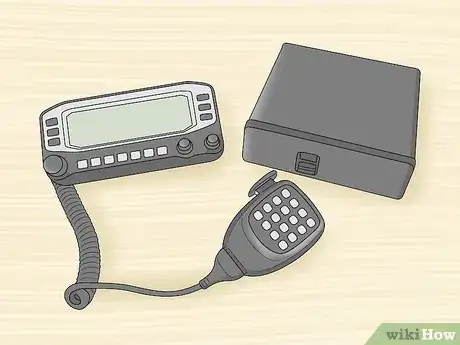
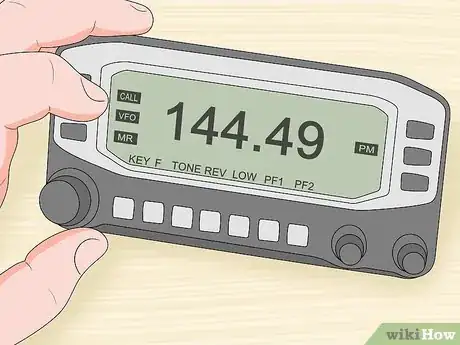
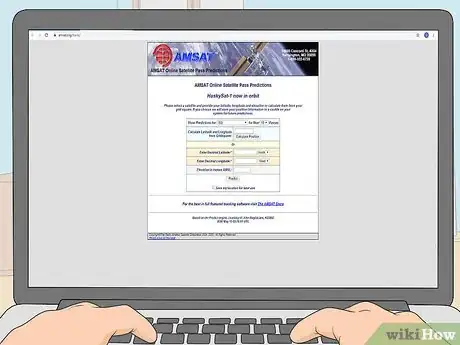
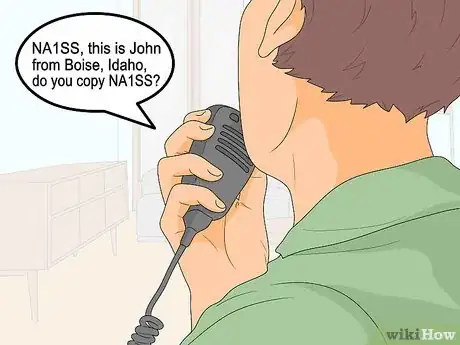

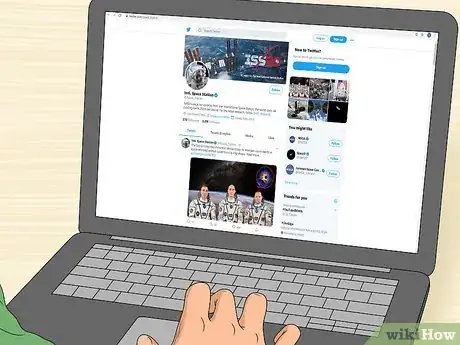
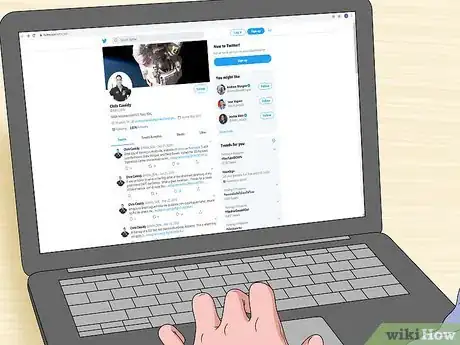
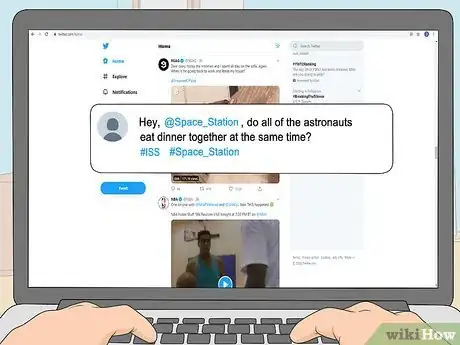
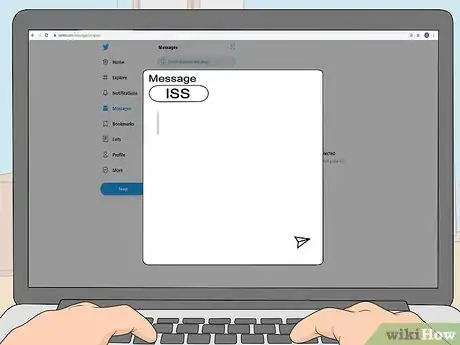



-Electric-Shock-Step-9.webp)






















































